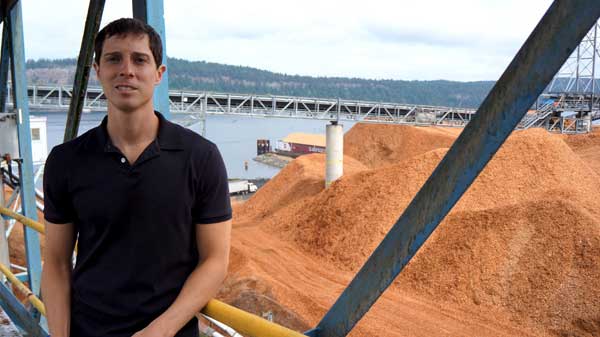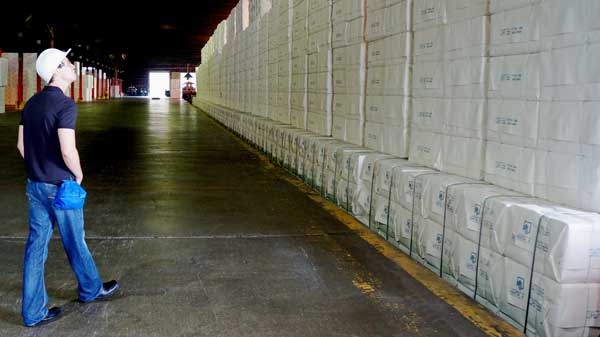It was the summer of 2008, hardly the ideal setting for the beginning of a forestry fairytale.
The global economy was on the brink of collapse and thousands of British Columbian forestry workers had already lost their jobs. Dozens of mills had either shuttered their gates for good or cut back on production as the U.S. housing market crumbled.
But that year saw a group of unemployed mill workers scrounge up enough cash to rescue their 50-year-old Nanaimo pulp mill and reinvigorate the region's largest private employer. With $25,000 each and the support of three local investment groups, Harmac Pacific's employees bought their pulp mill, saved their jobs and defied the odds.
This month they celebrate their fifth year in business. The mill is operating close to full capacity, employee share prices have increased significantly and workers earned dividends for the first time last Christmas.
History of a mill
When Pope & Talbot, the mill's previous owner, filed for bankruptcy in the fall of 2007, PricewaterhouseCoopers was charged with finding buyers for the Portland-based company's three B.C. mills.
It was obvious to Bob Smiley, a 40-year-old veteran of Harmac, that the only investors interested in buying Harmac were "chop-shop outfits" who would dismantle the mill, sell the parts and turn the land into a golf course or condo development.
"Everybody saw the value in the land, but nobody saw the value in the pulp mill -- except the employees," said the grey-haired, mustachioed Smiley, whose methodical recollection of events befits his years served as union treasurer.
Smiley was one of a trio of longtime Harmac staffers who brought the idea to the other employees. But his own story, the one he recounted recently sitting in the sparsely populated offices of the Harmac mill, where a faint miasma of decaying matter hangs in the air, starts much earlier.
Smiley's connection to Harmac stretches back to its inception. His father moved to B.C. from Saskatchewan after the Second World War, and was hired as one of the first workers to operate the newly constructed pulp mill.
The younger Smiley started working as a summer student at Harmac in the '70s -- what he called the "glory days of the pulp and paper industry."
Over the subsequent decades he would witness the rise of environmental regulations in the '80s, yo-yoing pulp and paper prices, the departure of MacMillan Bloedel and eventually, what could have been the end of the Harmac legacy.
Built in the late 1940s by MacMillan Bloedel and named after Harvey Reginald MacMillan (Har-Mac), a man who built up his forestry empire to eventually dominate the industry in B.C., the mill quickly became one of the world's foremost producers of northern bleached softwood kraft pulp. Known in the business as NBSK, this is a special kind of pulp used in the production of specialty papers, tissues, diapers, sanitary napkins, hospital gowns and even the conical membrane found in speakers.
In the mid-'90s MacMillan Bloedel started selling off its pulp and paper assets. For a while, Harmac operated as a stand-alone mill.
"When MacMillan Bloedel hived Harmac off, it became just a one-horse company," said Smiley. "It was perfect timing from our perspective. Pulp prices peaked in 1995 at around $1,000 per tonne," he said. "It was like a brave new world. We had been sort of cast off by M and B, but all of a sudden we were rolling in dough."
Eventually the storied Oregon-based company Pope & Talbot bought Harmac for $78 million. Pope & Talbot had an impressive pedigree: 150 years operating in the shipping, lumber and pulp industries.
But the company overextended itself in Canada. They bought more mills in B.C. through the '90s, largely financed by debt. Then the softwood lumber dispute erupted in 2001, resulting in massive duties levied on Canadian lumber bound for the U.S.
In 2001 and 2002 Pope & Talbot posted net losses in excess of $20 million. The company began to crumble under the weight of its debt.
Investors fled. The stock price tumbled from $23 per share in the spring of 2000 to five dollars by the end of 2005. Then, in the fall of 2007 the company filed for bankruptcy in Canada and the U.S. and the stock, when it eventually sunk to less than 10 cents per share, was bumped off the New York Stock Exchange.
Still, even as Pope & Talbot receded into bankruptcy, no one expected the Harmac mill to close completely.
Asia Pulp and Paper, a massive Indonesian company, made a $105-million offer to buy the mill in April 2008. But the deal fell apart at the last minute.
"The receiver came in, PricewaterhouseCoopers, and basically put a lock on the gate. And that was it," said Smiley. "Everybody went home."
"Right up until the very end, people didn't really think it was going to happen. They didn't believe the mill was going to shut down because it had always been there," he said. "Somebody will come."
But nobody came.
Plan B takes shape
That's when an idea that had been hatched as a backup plan started gaining momentum.
What if the employees bought the mill?
Smiley said they thought they needed $30 million to buy it from the receiver and have enough capital to get it running again. They thought they could raise $7 million from the employees and borrow the rest.
"We were naive enough to think that we could buy it on our own," said Smiley. "Of course, come August of '08, Jimmy Pattison couldn't borrow money.
"Things were starting to tighten up pretty good. That's when we started looking for other partners."
Levi Sampson was a fresh-faced 27-year-old at the time, working as a marketing manager for a Victoria gym, when he and his family decided to approach the Harmac employee group about investing their money in the cause.

Sampson's family money comes from the Alberta oil patch -- his father is CEO of Niko Resources, a Calgary-based oil and gas company with assets across Asia.
"Our family decided to make an investment. We saw a model that we thought would work," Sampson said, sitting in the corner office at the Harmac mill where he now serves as president and regularly travels the world marketing Harmac pulp. (The whole company is based at the Nanaimo mill site, a stark difference from the foreign corporate ownership models of the past.)
"We wouldn't have gotten involved in the forest industry if it wasn't for a change in mentality and a new way of doing things," he said.
Sampson said he saw two choices facing the unemployed Harmac workers: pack up their families and look for work elsewhere, or pony up $25,000 and buy back their jobs.
"When we started up this employee owned model, most of the media was writing us off -- most of the analysts as well," said Sampson.
Indeed, media and analysts at the time said the fact that the employees were the only group interested in investing illustrated the poor state of the pulp industry, and was a harbinger of the death of the B.C. forest sector.
"This is nothing short of tragic. H.R. MacMillan must be rolling over in his grave," one analyst said at the time.
"It would be great to see a local success story because of what the mill means to the Nanaimo economy, but the game has changed for the pulp industry," said another.
But Harmac's employees used that negative energy "as fuel" and forged ahead with their plan.
By the end of July the Harmac employees, along with the Sampson's, Williams Lake-based Pioneer Log Homes and Fraser Valley construction company Totzauer Holdings bought the mill for $13.2 million.
"They had to believe not only in themselves but also the people that they work with to get it done together," Sampson said.
Still weathering the storms
Smiley said 225 workers bought in, about half of the original 530 workers employed by Pope & Talbot.
"The [previous] couple years had been so difficult here," said Smiley. "It was hard for people to believe that things could change for the good," he said. "And a lot of people didn't come back, particularly people with transferable skills."
"I know that each and every individual went home and talked to their families, because it was a big commitment, not just financial commitment because people were out of their jobs, it was an emotional commitment," said Smiley.
For those that stayed, months of uncertainty and the prospect of losing their livelihoods erased the hard-fought battle lines that once divided hourly, unionized workers from salaried staff.
"We were all very romantic about what we were doing," Smiley said. Where every staff member is also an owner, squabbles about overtime and flexible job descriptions faded.
They had trimmed overhead costs way back. No expensive corporate head office. No costly hoard of executives. No fancy marketing and sales team.
But by the middle of 2009 the price for NBSK had bottomed out again at around $570 per tonne. Sampson's cost savings weren't enough.
"The first year, we were all bailing at the same time. The boat was sinking," Smiley said.
The union lent $1.2 million to Harmac to keep it afloat, Smiley said. "But I would say that if you asked people, they would say that was the best time. Everyone was rowing the boat together."
Harmac weathered the price collapse and has enjoyed a steadily increasing market ever since. The price for a tonne of NBSK costs around $950 today, and Harmac produces 280,000 tonnes every year.
The company has attracted more than 100 new employee-owners since 2008. While you don't have to buy a share in the company to work there, Smiley said most workers choose to.
Sampson said there will be a BBQ held this month to celebrate their fifth year in business, but also to mark the completion of a $45-million electrical generation plant.
The plant uses wood waste for fuel and will produce 25 megawatts of electricity, 15 of which will feed the BC Hydro power grid, providing enough electricity to light and heat 17,000 homes. The rest will go to powering the mill -- further cutting costs.
And, when the plant goes online, the company will have a second revenue stream for the first time in its history, and it will conclude more than $100 million in efficiency upgrades and carbon emissions reduction work.

Some of that money came from the federal government's Green Transformation fund, a billion-dollar aid package for the struggling pulp and paper industry.
The industry, worth $4.5 billion in Canada, is highly volatile. Prices routinely peak and plummet. And the latest bull market hasn't been enough to keep other B.C. mills from closing for good.
Sampson attributes his mill's success, in an environment rife with failures, to the unique model.
"We just go lean and mean and do things a little different," he said. His point was aptly illustrated on a tour of the mill site that revealed building after building of heavy, specialized equipment that seemed to require few operators, and a reception office with no receptionist; just a bale of pulp, apparently the mill's first product after restarting in 2008, adorned with the signatures of its many owners.
Harmac's unprecedented 11-year labour agreement also helps keep the mill operating smoothly. Lockouts aren't a problem when employees are also owners.
When asked if he thinks the employee-ownership model could be replicated elsewhere in the forestry industry, Sampson is reserved.
"I have had people talk to me from within the forestry industry [asking] if it could be duplicated somewhere else and if it could be successful somewhere else," he said. "My answer to that is always 'only if you have the right people in place and if you have the right group of individuals,' and that's from top to bottom.
"I also think it has to come from the workforce itself. I would never suggest for any employee ownership model, not just the forestry industry, to try to force that on a group of people. That's not a way for success. If it comes from the people who say they want to buy in, then it makes sense." ![]()
Read more: Labour + Industry















Tyee Commenting Guidelines
Comments that violate guidelines risk being deleted, and violations may result in a temporary or permanent user ban. Maintain the spirit of good conversation to stay in the discussion.
*Please note The Tyee is not a forum for spreading misinformation about COVID-19, denying its existence or minimizing its risk to public health.
Do:
Do not: